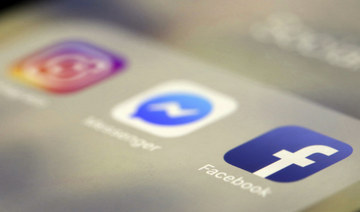WASHINGTON: The stranger-than-sitcom American presidency opened 2018 with a big tease about mutual nuclear destruction from two leaders who then found “love” not war. It seems President Donald Trump and North Korea’s Kim Jong Un were just playing hard to get.
The presidency ends the year saturated in tumult, with the government in partial shutdown and Trump tweeting a video of himself warbling a parody of the theme song from “Green Acres,” a television sitcom from the 1960s, to mark his signing of a farm bill.
Throw in a beer-loving and very angry Supreme Court nominee, an unhappy departing defense secretary, Trump’s parallel universe of facts and his zillion tweets, and you can see that the president’s world this year was touched by the weird, the traumatic and the fantastical — also known as WTF.
There was no holding back the self-described “very stable genius” with the “very, very large brain.”
Some serious and relatively conventional things got done in 2018.
There was a midterm election. Many more Democrats are coming to Congress and not quite all of them plan to run for president. Divided government dawns in January when Democrats take control of the House; Republicans retain their grip on the Senate.
An overhaul of the criminal justice system was accomplished, and in an unusually bipartisan way, though it took a dash of reality TV’s Kim Kardashian West to move it along. Gun control actually was tightened a bit, with Trump’s unilateral banning of bump stocks.
Trump shocked allies and lost Defense Secretary Jim Mattis over a presidential decision to pull US troops out of Syria, quickly following up with indications that up to half the troops in Afghanistan might be withdrawn, too.
Self-described “Tariff Man” started one trade war, with China, and headed off a second by tweaking the North American Free Trade Agreement and giving it an unpronounceable acronym, USMCA. He withdrew the US from the Iran nuclear deal, putting action behind his Twitter shout: “WE ARE NO LONGER A COUNTRY THAT WILL STAND FOR YOUR DEMENTED WORDS OF VIOLENCE & DEATH.”
Trump placed his second justice on the Supreme Court in two years after Brett Kavanaugh, accused of alcohol-fueled sexual assault in his youth, raged against the allegations at a congressional hearing and acknowledged only: “I liked beer, I still like beer,” but “I never sexually assaulted anyone.”
There were frustrations and fulminations aplenty for the president, particularly about the steaming-ahead Russia-Trump campaign investigation by special counsel Robert Mueller (“special councel” in some Trump tweets).
Nor did he make much progress on his promised border wall (“boarder wall“), which he renamed “artistically designed steel slats” in December in what he regarded as a concession to wall-despising, concrete-cursing Democrats. The concession did not work: large parts of the government closed Saturday over the wall-induced budget impasse.
He took heat for a zero-tolerance policy that forced migrant children from their parents until he backed off, inaccurately blaming Democrats for “Child Seperation.”
It was a very good year for jobs. It was a check-your-smartphone-right-now, pass-the-smelling-salts year for the stock market. Trump, who assailed the unemployment rate as a phony measure when he was a candidate, couldn’t speak of it enough as Obama-era job growth continued on his watch. He went mum about the market, a prime subject for his boasting before it took a sustained dive.
Trump’s approval rating in polls was one of the few constants on this swiftly tilting planet: 42 percent approval and 56 percent disapproval in The Associated Press-NORC’s latest and 38 percent-57 percent via Gallup, neither much different than in January.
Through it all, the mainstreaming of the bizarre proceeded apace and North Korea’s Kim set that tone right on Jan. 1 with his New Year cheer to Americans across the ocean: “It’s not a mere threat but a reality that I have a nuclear button on the desk in my office. All of the mainland United States is within the range of our nuclear strike.”
Trump responded the next day with a tweet about size and performance. “I too have a Nuclear Button, but it is a much bigger & more powerful one than his, and my Button works!“
Once they got that out of their system, things quickly improved, helped along by Kim’s letters to Trump, which the US president called “beautiful.” There was no more talk about Trump being a “mentally deranged dotard” or Kim being a “maniac,” the musty insults of an earlier time. In June, they held history’s first meeting between a North Korean leader and a current US president. “We fell in love,” Trump later said at a West Virginia rally.
Kim had previously vowed to visit “fire and fury” on the US but the “Fire and Fury” that made Trump livid early this year was the book of the same name, Michael Wolff’s insider account of the Trump White House. That was a different sort of missile. The president took particular exception to observations in the book by his former chief strategist, tweeting about “Sloppy Steve Bannon, who cried when he got fired and begged for his job. Now Sloppy Steve has been dumped like a dog by almost everyone. Too bad!“
They are said to be on better terms now.
Over the course of the year, Trump spoke at more than 40 campaign rallies, kept up his Twitter barrage (40,000 tweets since 2009 on his @realDonaldTrump account) and answered plenty of questions in infrequent but lengthy news conferences and sit-down interviews.
So what stands out in this blizzardy whiteout of unconventionality?
How about this farewell to his secretary of state, Rex Tillerson? “He was dumb as a rock and I couldn’t get rid of him fast enough. He was lazy as hell.” (The president usually reserves “dumb as a rock” for journalists.)
Or his description of Stormy Daniels, paid to stay quiet about their alleged affair, as “horseface?“
Or this description of his attorney general, Jeff Sessions, as “scared stiff and Missing in Action,” before Sessions was finally out in November?
Will history long remember that in 2018 the president called Democratic Rep. Adam Schiff “little Adam Schitt” on Twitter and nations in Africa “shithole countries” in a private meeting?
Or that he (correctly) predicted Hurricane Florence would be “tremendously wet” or told the AP: “I have a natural instinct for science?“
In July, Trump appeared to side with Russian President Vladimir Putin when he stood by Putin’s side at a Helsinki summit news conference and gave weight to Putin’s denial that Russia meddled in the 2016 election, despite the firm conclusion of US intelligence agencies that it had. “I don’t see any reason why it would be” Russia, Trump said.
But while it’s been hardly noticed in a capital consumed by the shutdown drama, Mattis, Syria, steel slats and market convulsions, 2018 draws to a close as it started — with warnings of a nuclear Armageddon, this time from Putin.
Putin’s prompt was Trump’s intention to walk away from one arms control treaty and his reluctance to extend another.
That, said Putin, “could lead to the destruction of civilization as a whole and maybe even our planet.”
Maybe he’s just playing hard to get.
North Korea, Kavanaugh, all those Trump tweets and more in 2018
North Korea, Kavanaugh, all those Trump tweets and more in 2018

- Over the course of the year, Trump spoke at more than 40 campaign rallies, kept up his Twitter barrage (40,000 tweets since 2009 on his @realDonaldTrump account) and answered plenty of questions
Advocacy group ‘alarmed’ as journalists shot at in West Bank

- Al-Araby TV workers were not injured but their equipment was destroyed
- Ameed Shehade, Rabih Al-Monayar were wearing ‘Press’ vests at time of attack
LONDON: American advocacy group the Committee to Protect Journalists says it is “extremely concerned” after hearing reports that two Al-Araby TV journalists were shot at by Israeli forces in the West Bank on Saturday.
Reporter Ameed Shehade and camera operator Rabih Al-Monayar came under fire while they were covering an Israeli raid on the village of Deir al-Ghusun in Tulkarm.
Neither of the men was injured in the attack but their equipment was destroyed.
The CPJ urged Israel to launch an investigation into whether the journalists were deliberately targeted.
“CPJ is alarmed by the Israeli soldiers’ shooting at two Al-Araby TV journalists, which hit their camera, while they were reporting in the West Bank,” the group’s Program Director Carlos Martinez de la Serna said.
Although he was “relieved” that the journalists had not been injured, he said he questioned whether the targeting was intentional as it was the second case of reporters being attacked while doing their jobs.
Al-Araby TV aired footage of the two men, who were wearing blue vests labeled “Press,” taking cover near their car.
Shehade said the shots were fired from a vehicle about 20 meters (22 yards) away and that they were clearly visible to the soldier.
Another journalist who was reporting on the raids confirmed that Shehade and Al-Monayar could be easily identified as members of the press.
According to The Guardian, Israeli forces killed five Palestinians in the overnight raid. Hamas confirmed that four of the men killed were from its al-Qassam armed wing.
Al-Monayar and Shehade suffered a similar attack in July last year while reporting on an Israeli operation against militants in the Jenin refugee camp in the West Bank. They again escaped personal injury but their video equipment was damaged.
Russia charges journalist with ‘justifying terrorism’

- Nadezhda Kevorkova was arrested for two Telegram posts regarding an Islamist raid and Afghanistan, her son reports
- The journalist specialized in coverage of the Middle East
MOSCOW: Russia has detained prominent journalist Nadezhda Kevorkova and charged her with “justifying terrorism” over posts on her Telegram account, her lawyer said Monday.
Kevorkova, 65, wrote for a number of outlets including Novaya Gazeta and Russia Today and specialized in coverage of the Middle East, including the Israeli-Palestinian conflict.
“Nadezhda Kevorkova has been detained and will be taken to a temporary detention center today. The matter of pre-trial restrictions will be decided tomorrow,” lawyer Kaloy Akhilgov said.
The charges relate to two posts on her Telegram from 2018 and 2021, one a re-post from another journalist about the 2005 Islamist raid on Nalchik and the other about Afghanistan, he said.
The raid on Nalchik, a city in Russia’s North Caucasus, saw armed Islamist militants target government and security buildings in an attack that left dozens of people dead.
Her ex-husband Maxim Shevchenko, who presents a talk show on state television, rejected the charges against her.
“Nadezhda Kevorkova never justified terrorism and never justified the attack on Nalchik ... but as a journalist, she certainly wrote about torture during the investigation,” he said.
Russia has waged an unprecedented crackdown on freedom of the press since launching its full-scale offensive in Ukraine, silencing and detaining journalists at odds with the Kremlin.
Media watchdogs raise alarm over Al Jazeera ban, call for it to be lifted

- Israel’s decision sets ‘dangerous precedent,’ Committee to Protect Journalists says
- News channel vows to continue Gaza coverage, will pursue ‘every legal step’ to fight block
LONDON: Media watchdogs have condemned Israel’s decision to block Al Jazeera, raising concerns about the erosion of media freedom in the country, especially amid the ongoing conflict in Gaza.
The US-based Committee to Protect Journalists said the government’s decision set a dangerous precedent for other international media outlets operating in Israel.
“CPJ condemns the closure of Al Jazeera’s office in Israel and the blocking of the channel’s websites,” program director Carlos Martinez de la Serna said in New York.
Israel should allow Al Jazeera and all international media outlets to operate freely, particularly during wartime, he said.
The Committee to Protect Journalists condemns the Israeli cabinet’s decision to shut down Al-Jazeera’s operations in Israel and warns that the vote could set a dangerous precedent for other international media outlets working in Israel. Our statement:https://t.co/X4wQEsYl1b
— Committee to Protect Journalists (@pressfreedom) May 5, 2024
Israel’s executive authority voted on Sunday to pass a law allowing the temporary shutdown of a foreign channel’s broadcasts if the content was deemed to be a threat to security during the ongoing war.
Soon after Prime Minister Benjamin Netanyahu announced the decision, reports emerged of raids on the offices of the Qatar-backed broadcaster.
The Foreign Press Association released a statement condemning the decision as a “dark day for the media” and accused Israel of joining “a dubious club of authoritarian governments” by banning the broadcasts.
The UN’s Human Rights office also urged the Israeli government to reverse the ban
“A free & independent media is essential to ensuring transparency & accountability. Now, even more so given tight restrictions on reporting from Gaza,” it said on X.
We regret cabinet decision to close Al Jazeera in Israel. A free & independent media is essential to ensuring transparency & accountability. Now, even more so given tight restrictions on reporting from Gaza. Freedom of expression is a key human right. We urge govt to overturn ban
— UN Human Rights (@UNHumanRights) May 5, 2024
There has also been criticism of the decision from within the country, with the Association for Civil Rights in Israel filing a request to the Supreme Court to overturn the ban.
The news came amid a yearslong campaign waged against Al Jazeera by the Israeli government, which accuses it of anti-Israeli bias and “being a mouthpiece for Hamas.”
The broadcaster rejected the claims and said it would “pursue every legal step” to fight the decision.
Al Jazeera also vowed to continue its coverage from Gaza, as it remains one of the few networks with a strong presence on the ground, as foreign journalists are banned from entering the Strip without Israeli army supervision.
The network accused Israel of deliberately targeting its staff in an attempt to silence them.
“Israel’s suppression of free press to cover up its crimes by killing and arresting journalists has not deterred us from performing our duty,” it said in its response to Sunday’s ban.
Despite the ruling, the channel remains accessible through Facebook in Israel.
‘Everybody is vulnerable’: Fake US school audio stokes AI alarm

- The clip, which left administrators of Pikesville High School fielding a flood of angry calls and threats, underscores the ease with which widely available AI and editing tools can be misused to impersonate celebrities and everyday citizens alike
WASHINGTON: A fabricated audio clip of a US high school principal prompted a torrent of outrage, leaving him battling allegations of racism and anti-Semitism in a case that has sparked new alarm about AI manipulation.
Police charged a disgruntled staff member at the Maryland school with manufacturing the recording that surfaced in January — purportedly of principal Eric Eiswert ranting against Jews and “ungrateful Black kids” — using artificial intelligence.
The clip, which left administrators of Pikesville High School fielding a flood of angry calls and threats, underscores the ease with which widely available AI and editing tools can be misused to impersonate celebrities and everyday citizens alike.
In a year of major elections globally, including in the United States, the episode also demonstrates the perils of realistic deepfakes as the law plays catch-up.
“You need one image to put a person into a video, you need 30 seconds of audio to clone somebody’s voice,” Hany Farid, a digital forensics expert at the University of California, Berkeley, told AFP.
“There’s almost nothing you can do unless you hide under a rock.
“The threat vector has gone from the Joe Bidens and the Taylor Swifts of the world to high school principals, 15-year-olds, reporters, lawyers, bosses, grandmothers. Everybody is now vulnerable.”
After the official probe, the school’s athletic director, Dazhon Darien, 31, was arrested late last month over the clip.
Charging documents say staffers at Pikesville High School felt unsafe after the audio emerged. Teachers worried the campus was bugged with recording devices while abusive messages lit up Eiswert’s social media.
The “world would be a better place if you were on the other side of the dirt,” one X user wrote to Eiswert.
Eiswert, who did not respond to AFP’s request for comment, was placed on leave by the school and needed security at his home.
When the recording hit social media in January, boosted by a popular Instagram account whose posts drew thousands of comments, the crisis thrust the school into the national spotlight.
The audio was amplified by activist DeRay McKesson, who demanded Eiswert’s firing to his nearly one million followers on X. When the charges surfaced, he conceded he had been fooled.
“I continue to be concerned about the damage these actions have caused,” said Billy Burke, executive director of the union representing Eiswert, referring to the recording.
The manipulation comes as multiple US schools have struggled to contain AI-enabled deepfake pornography, leading to harassment of students amid a lack of federal legislation.
Scott Shellenberger, the Baltimore County state’s attorney, said in a press conference the Pikesville incident highlights the need to “bring the law up to date with the technology.”
His office is prosecuting Darien on four charges, including disturbing school activities.
Investigators tied the audio to the athletic director in part by connecting him to the email address that initially distributed it.
Police say the alleged smear-job came in retaliation for a probe Eiswert opened in December into whether Darien authorized an illegitimate payment to a coach who was also his roommate.
Darien made searches for AI tools via the school’s network before the audio came out, and he had been using “large language models,” according to the charging documents.
A University of Colorado professor who analyzed the audio for police concluded it “contained traces of AI-generated content with human editing after the fact.”
Investigators also consulted Farid, writing that the California expert found it was “manipulated, and multiple recordings were spliced together using unknown software.”
AI-generated content — and particularly audio, which experts say is particularly difficult to spot — sparked national alarm in January when a fake robocall posing as Biden urged New Hampshire residents not to vote in the state’s primary.
“It impacts everything from entire economies, to democracies, to the high school principal,” Farid said of the technology’s misuse.
Eiswert’s case has been a wake-up call in Pikesville, revealing how disinformation can roil even “a very tight-knit community,” said Parker Bratton, the school’s golf coach.
“There’s one president. There’s a million principals. People are like: ‘What does this mean for me? What are the potential consequences for me when someone just decides they want to end my career?’“
“We’re never going to be able to escape this story.”
Lawsuit against Meta asks if Facebook users have right to control their feeds using external tools

- The tool, called Unfollow Everything 2.0, is a browser extension that would let Facebook users unfollow friends, groups and pages and empty their newsfeed — the stream of posts, photos and videos that can keep them scrolling endlessly
Do social media users have the right to control what they see — or don’t see — on their feeds?
A lawsuit filed against Facebook parent Meta Platforms Inc. is arguing that a federal law often used to shield Internet companies from liability also allows people to use external tools to take control of their feed — even if that means shutting it off entirely.
The Knight First Amendment Institute at Columbia University filed a lawsuit Wednesday against Meta Platforms on behalf of an Amherst professor who wants to release a tool that enables users to unfollow all the content fed to them by Facebook’s algorithm.
The tool, called Unfollow Everything 2.0, is a browser extension that would let Facebook users unfollow friends, groups and pages and empty their newsfeed — the stream of posts, photos and videos that can keep them scrolling endlessly. The idea is that without this constant, addicting stream of content, people might use it less. If the past is any indication, Meta will not be keen on the idea.
A UK developer, Louis Barclay, released a similar tool, called Unfollow Everything, but he took it down in 2021, fearing a lawsuit after receiving a cease-and-desist letter and a lifetime Facebook ban from Meta, then called Facebook Inc.
With Wednesday’s lawsuit, Ethan Zuckerman, a professor at the University of Massachusetts at Amherst, is trying to beat Meta to the legal punch to avoid getting sued by the social media giant over the browser extension.
“The reason it’s worth challenging Facebook on this is that right now we have very little control as users over how we use these networks,” Zuckerman said in an interview. “We basically get whatever controls Facebook wants. And that’s actually pretty different from how the Internet has worked historically.” Just think of email, which lets people use different email clients, or different web browsers, or anti-tracking software for people who don’t want to be tracked.
Meta declined to comment.
The lawsuit filed in federal court in California centers on a provision of Section 230 of the 1996 Communications Decency Act, which is often used to protect Internet companies from liability for things posted on their sites. A separate clause, though, provides immunity to software developers who create tools that “filter, screen, allow, or disallow content that the provider or user considers to be obscene, lewd, lascivious, filthy, excessively violent, harassing, or otherwise objectionable.”
The lawsuit, in other words, asks the court to determine whether Facebook users’ news feed falls into the category of objectionable material that they should be able to filter out in order to enjoy the platform.
“Maybe CDA 230 provides us with this right to build tools to make your experience of Facebook or other social networks better and to give you more control over them,” said Zuckerman, who teaches public policy, communication and information at Amherst. “And you know what? If we’re able to establish that, that could really open up a new sphere of research and a new sphere of development. You might see people starting to build tools to make social networks work better for us.”
While Facebook does allow users to manually unfollow everything, the process can be cumbersome with hundreds or even thousands of friends, groups and businesses that people often follow.
Zuckerman also wants to study how turning off the news feed affects people’s experience on Facebook. Users would have to agree to take part in the study — using the browser tool does not automatically enroll participants.
“Social media companies can design their products as they want to, but users have the right to control their experience on social media platforms, including by blocking content they consider to be harmful,” said Ramya Krishnan, senior staff attorney at the Knight Institute. “Users don’t have to accept Facebook as it’s given to them. The same statute that immunizes Meta from liability for the speech of its users gives users the right to decide what they see on the platform.”




















